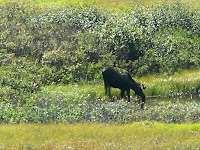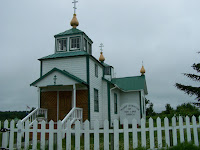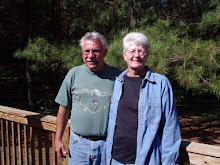Denali National Park - the second time
As you know, our son Jason flew out for two weeks to experience Alask a with us and after picking him up in Anchorage, we headed for D
a with us and after picking him up in Anchorage, we headed for D enali National Park and the Talkitna Camping area which is 29 miles into the park for 4 nights. Once in the campground, visitors are restricted to only going further into the park on the buses. If you head back into the small town at the entrance to the park, or back to the visitor's center, then you lose your camp site. If you go in by the bus, then you have to pay the fee to go back to the campground. So . . .before we entered the park we made sure we had plenty of supplies, including propane, food and water.
enali National Park and the Talkitna Camping area which is 29 miles into the park for 4 nights. Once in the campground, visitors are restricted to only going further into the park on the buses. If you head back into the small town at the entrance to the park, or back to the visitor's center, then you lose your camp site. If you go in by the bus, then you have to pay the fee to go back to the campground. So . . .before we entered the park we made sure we had plenty of supplies, including propane, food and water.
 a with us and after picking him up in Anchorage, we headed for D
a with us and after picking him up in Anchorage, we headed for D enali National Park and the Talkitna Camping area which is 29 miles into the park for 4 nights. Once in the campground, visitors are restricted to only going further into the park on the buses. If you head back into the small town at the entrance to the park, or back to the visitor's center, then you lose your camp site. If you go in by the bus, then you have to pay the fee to go back to the campground. So . . .before we entered the park we made sure we had plenty of supplies, including propane, food and water.
enali National Park and the Talkitna Camping area which is 29 miles into the park for 4 nights. Once in the campground, visitors are restricted to only going further into the park on the buses. If you head back into the small town at the entrance to the park, or back to the visitor's center, then you lose your camp site. If you go in by the bus, then you have to pay the fee to go back to the campground. So . . .before we entered the park we made sure we had plenty of supplies, including propane, food and water. The campground hosts - Mike and Patricia were very helpful in getti ng us signed up for hikes and bus tours. The first day we signed up for th
ng us signed up for hikes and bus tours. The first day we signed up for th e Tek bus - which is a guaranteed seat the first time you get on it - after that it is free but you can only get on a bus that has extra seats and not filled up with first time riders. The second day we signed up for the bus that goes to the very end of the park where vehicular traffic is allowed. There are points further out, but it is by foot traffic only. Jason also signed up for a ranger led hike on the 3rd day. Ken was going to go, but didn't have the proper footwear - and they are pretty strict about that as they don't want injuries out in the tundra.
e Tek bus - which is a guaranteed seat the first time you get on it - after that it is free but you can only get on a bus that has extra seats and not filled up with first time riders. The second day we signed up for the bus that goes to the very end of the park where vehicular traffic is allowed. There are points further out, but it is by foot traffic only. Jason also signed up for a ranger led hike on the 3rd day. Ken was going to go, but didn't have the proper footwear - and they are pretty strict about that as they don't want injuries out in the tundra.
 ng us signed up for hikes and bus tours. The first day we signed up for th
ng us signed up for hikes and bus tours. The first day we signed up for th e Tek bus - which is a guaranteed seat the first time you get on it - after that it is free but you can only get on a bus that has extra seats and not filled up with first time riders. The second day we signed up for the bus that goes to the very end of the park where vehicular traffic is allowed. There are points further out, but it is by foot traffic only. Jason also signed up for a ranger led hike on the 3rd day. Ken was going to go, but didn't have the proper footwear - and they are pretty strict about that as they don't want injuries out in the tundra.
e Tek bus - which is a guaranteed seat the first time you get on it - after that it is free but you can only get on a bus that has extra seats and not filled up with first time riders. The second day we signed up for the bus that goes to the very end of the park where vehicular traffic is allowed. There are points further out, but it is by foot traffic only. Jason also signed up for a ranger led hike on the 3rd day. Ken was going to go, but didn't have the proper footwear - and they are pretty strict about that as they don't want injuries out in the tundra. 
The night we got to the campground, there was a ranger talk which we went to. It was all about the different raptors and animal life in the park. Quite interesting and the ranger was very entertaining and good with getting everyone involved.
The next morning we boarded the Tek bus around 9:30 in the morning. We were all excited about what we were going to see and saw quite a lot. Without a lot of dialogue, I am going to post the pictures which speak for themselves. All in all, it was a great day - a little cloudy but not enough to stop up from seeing Denali - what a beautiful sight.
The second d ay, we boarded the bus to go to the end of the park. Well, Shandr
ay, we boarded the bus to go to the end of the park. Well, Shandr a the bus driver, didn't let any moss grow under her wheels. She was the worst driver we have had and before I asked her what she did over the winter I told Ken - I'll bet she is a school bus driver. I asked and she is!! We managed to have a good time even through her dressing us down like kids that won't behave. Because some one stuck their camera out of the window and didn't get back inside quick en
a the bus driver, didn't let any moss grow under her wheels. She was the worst driver we have had and before I asked her what she did over the winter I told Ken - I'll bet she is a school bus driver. I asked and she is!! We managed to have a good time even through her dressing us down like kids that won't behave. Because some one stuck their camera out of the window and didn't get back inside quick en ough, the next time we saw something she positioned the bus so only on
ough, the next time we saw something she positioned the bus so only on e side - the good side - could see it. Her main objective was not to have the passengers enjoy the ride, it was to get done so she could get back to the garage before a certain time. In spite of her attitude we didn't let it deter us from enjoying the park.
e side - the good side - could see it. Her main objective was not to have the passengers enjoy the ride, it was to get done so she could get back to the garage before a certain time. In spite of her attitude we didn't let it deter us from enjoying the park.
 ay, we boarded the bus to go to the end of the park. Well, Shandr
ay, we boarded the bus to go to the end of the park. Well, Shandr a the bus driver, didn't let any moss grow under her wheels. She was the worst driver we have had and before I asked her what she did over the winter I told Ken - I'll bet she is a school bus driver. I asked and she is!! We managed to have a good time even through her dressing us down like kids that won't behave. Because some one stuck their camera out of the window and didn't get back inside quick en
a the bus driver, didn't let any moss grow under her wheels. She was the worst driver we have had and before I asked her what she did over the winter I told Ken - I'll bet she is a school bus driver. I asked and she is!! We managed to have a good time even through her dressing us down like kids that won't behave. Because some one stuck their camera out of the window and didn't get back inside quick en ough, the next time we saw something she positioned the bus so only on
ough, the next time we saw something she positioned the bus so only on e side - the good side - could see it. Her main objective was not to have the passengers enjoy the ride, it was to get done so she could get back to the garage before a certain time. In spite of her attitude we didn't let it deter us from enjoying the park.
e side - the good side - could see it. Her main objective was not to have the passengers enjoy the ride, it was to get done so she could get back to the garage before a certain time. In spite of her attitude we didn't let it deter us from enjoying the park.
Third day, Jason went on the ranger led hike which he enjoyed immensely. Ken went on his own hike up to the top of a nearby mountain and he also enjoyed himself. As for me, I stayed at the RV and did some quilting, reading and cooking - and I also enjoyed myself!
The fourth day and the day we were to leave, Jason left for a hike into the tundra on his own while Ken and I packed up the RV and headed out to the main gate to dump the tanks, refill the water and take showers. Jason got a bus ride back up to where we were and he also availed himself of the shower before we headed down to Portage, Whittier and Seward for a re-visit.

As you can see - animals have the right of way in the park. If they are on the road, the drivers stop to let them either cross or walk along the road until they are tired of it and veer off into the tundra.
We are ready! Please take our picture!!!










































